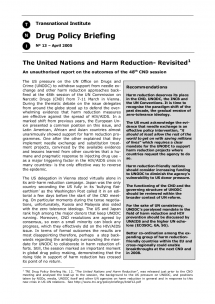Ideas into movement
Boost TNI's work
50 years. Hundreds of social struggles. Countless ideas turned into movement.
Support us as we celebrate our 50th anniversary in 2024.

In this briefing the Transnational Institute (TNI) analyses the proceedings and results of the CND meeting in Vienna, 7-11 March 2005, outlines several options for follow-up and recommends next steps to take.

The US pressure on the UN Office on Drugs and Crime (UNODC) to withdraw support from needle exchange and other harm reduction approaches backfired at the 48th session of the UN Commission on Narcotic Drugs (CND) from 7-11 March in Vienna. During the thematic debate on the issue delegates from around the globe stood up to defend the overwhelming evidence that harm reduction measures are effective against the spread of HIV/AIDS. In a marked shift from previous years, the European Union presented a common position on this issue, and Latin American, African and Asian countries almost unanimously showed support for harm reduction programmes. One after the other explained that they implement needle exchange and substitution treatment projects, convinced by the available evidence and lessons learned from other countries that a humane and pragmatic response to injecting drug use -as a major triggering factor in the HIV/AIDS crisis in many countries- is the only effective way to reverse the epidemic.
The US delegation in Vienna stood virtually alone in its anti-harm reduction campaign. Japan was the only country seconding the US fully in its 'bullying flat-earthism' as the Washington Post called it in an editorial a few days before the start of the CND meeting. On particular moments during the tense negotiations, unfortunately, Russia and Malaysia also sided with the zero tolerance ideology. The US and Japan rank high among the major donors that keep UNODC running. Moreover, CND resolutions are agreed by consensus, so even a small mi-nority can block any progress, which they effectively did on the HIV/AIDS issue. In terms of formal outcomes the results are most disappointing therefore, perhaps a step backwards regarding the ambiguity surrounding the mandate for UNODC to collaborate in harm reduction efforts. Still, the session marked an important moment in global drug policy making, demonstrating that the rising tide in support of harm reduction has crossed its point of no return.
Recommendations
Pages: 12